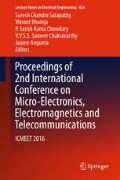Abstract
Cardiac Arrhythmia is caused by irregular heart rhythms, it is either increased or decreased leading to irregular rhythms. The heart arrhythmia is assessed using electrocardiogram (ECG). ECG can clearly detect various types of arrhythmia and correspond to diagnosis of heart disease. There is extensive research involved in removing manual intervention in assessing the type of arrhythmia from the ECG. Arrhythmia can be classified by extracting attributes in the form of RR interval from ECG. This work proposes an approach to classify cardiac arrhythmia. A range of classifiers are proposed such as Chi-square Automatic Interaction Detector (CHAID), Random Forest (RF), and fuzzy classifier. Initially, the attributes are retrieved from the time series present in ECG data employing Discrete Cosine Transform (DCT) and then the distance among RR waves are processed. The dataset used for experimental purpose were obtained from Massachusetts Institute of Technology-Boston’s Beth Israel Hospital (MIT-BIH) arrhythmia to evaluate the performance of the method.
Access this chapter
Tax calculation will be finalised at checkout
Purchases are for personal use only
References
Sharma, P., & Kaur, L. (2012). Identification of Cardiac Arrhythmias using ECG. International Journal of Computer Technology and Applications, 3(1).
Gothwal, H., Kedawat, S., & Kumar, R. (2011). Cardiac arrhythmias detection in an ECG beat signal using fast fourier transform and artificial neural network. Journal of Biomedical Science and Engineering, 4(04), 289.
Rawther, N. N., & Cheriyan, J. (2015). Detection and Classification of Cardiac Arrhythmias based on ECG and PCG using Temporal and Wavelet features. International Journal of Advanced Research in Computer and Communication Engineering, Vol. 4, Issue 4.
Durham, D., & Worthley, L. I. (2002). Cardiac arrhythmias: diagnosis and management. The tachycardias. Critical Care and Resuscitation, 4(1), 35.
Khandait, P. D., Bawane, N. G., & Limaye, S. S. (2012). Features Extraction of ECG Signal for detection of cardiac arrhythmias. International Journal of Computer Applications, 2(1), 520–525.
Abhinav-Vishwa, M. K., Lal, S. D., & Vardwaj, P. (2011). Classification of arrhythmic ECG data using machine learning techniques. International Journal of Interactive Multimedia and Artificial Intelligence, 1(4).
M Jadhav, S., L Nalbalwar, S., & A Ghatol, A. (2012). Artificial neural network models based cardiac arrhythmia disease diagnosis from ECG signal data. International Journal of Computer Applications, 44(15), 8–13.
Kumar, G. R., & Kumaraswamy, Y. S. (2014). Spline activated neural network for classifying cardiac arrhythmia. Journal of Computer Science, 10(8), 1582.
Kumar, R. G., & Kumaraswamy, Y. S. (2012). Investigation of Support Vector Machine To Assess Cardiac Arrhythmia. In Int. Conf. on Advances in Computer and Electrical Engineering (ICACEE’2012) Nov (pp. 17–18).
Kadhar Nawaz, G. M. (2014). Analysis of Optimization Techniques in Chi-Squared Automatic Interaction Detection. Journal of Theoretical & Applied Information Technology, 65(3).
Tang, T. I., Zheng, G., Huang, Y., Shu, G., & Wang, P. (2005). A comparative study of medical data classification methods based on decision tree and system reconstruction analysis. Industrial Engineering and Management Systems, 4(1), 102–108.
Ganeshkumar, R., & Yskumaraswamy, D. (2012). Investigating cardiac arrhythmia in ECG using random forest classification. International Journal of Computer Applications, 37(4), 31–34.
Jovic, A., & Bogunovic, N. (2012). Evaluating and comparing performance of feature combinations of heart rate variability measures for cardiac rhythm classification. Biomedical Signal Processing and Control, 7(3), 245–255.
Anuradha, B., Reddy, V., & Veera, C. (2008). Cardiac arrhythmia classification using fuzzy classifiers. Journal of Theoretical and Applied Information Technology, 4(4), 353–359.
Author information
Authors and Affiliations
Corresponding author
Editor information
Editors and Affiliations
Rights and permissions
Copyright information
© 2018 Springer Nature Singapore Pte Ltd.
About this paper
Cite this paper
Sridhar, G.V., Mallikarjuna Rao, P. (2018). Framework for Classifying Cardiac Arrhythmia. In: Satapathy, S., Bhateja, V., Chowdary, P., Chakravarthy, V., Anguera, J. (eds) Proceedings of 2nd International Conference on Micro-Electronics, Electromagnetics and Telecommunications. Lecture Notes in Electrical Engineering, vol 434. Springer, Singapore. https://doi.org/10.1007/978-981-10-4280-5_16
Download citation
DOI: https://doi.org/10.1007/978-981-10-4280-5_16
Published:
Publisher Name: Springer, Singapore
Print ISBN: 978-981-10-4279-9
Online ISBN: 978-981-10-4280-5
eBook Packages: EngineeringEngineering (R0)

